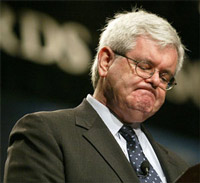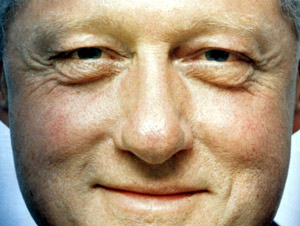
You’re welcome to send your Live Wire news tips or suggestions to [email protected].
Today’s Live Wire: Quick Links
- Gingrich Lead Vanishes
- Gingrich Soars Past Romney in Florida
- Supremes Say No to Cops’ GPS Tracking
- Obama’s State-of-the-Campaign Speech
- Bring Back Bill Clinton
- Chart Porn: Florida’s Population Changes
- Children and Israel’s Abu Ghraib
- The Lockout War on Unions
- Homage to Ellsworth Kelly
- Time-Lapsed Splendor: Yosemite
- The iPhone Talks Back
![]()
 On Wednesday morning, Quinnipiac University university released a poll showing Newt Gingrich carrying his new momentum from South Carolina into Florida. That momentum has evaporated. In a new poll released Friday, Gingrich, who never actually led Romney in the earlier Quinnipiac poll but did so in some others, is losing to Romney, 38-29 percent. From Quinnipiac: “”Speaker Newt Gingrich’s momentum from his South Carolina victory appears to have stalled and Gov. Mitt Romney seems to be pulling away in Florida,” said Peter A. Brown, assistant director of the Quinnipiac University Polling Institute. “Romney also has a better favorability rating from likely primary voters, which supports his lead in the horse race. Of course, with four days before Election Day, there is time for another reversal. Three in 10 voters say they might change their mind.” […] “With the debates now over, Gingrich will need some other way to reverse the tide that appears to be going against him,” Brown added.”
On Wednesday morning, Quinnipiac University university released a poll showing Newt Gingrich carrying his new momentum from South Carolina into Florida. That momentum has evaporated. In a new poll released Friday, Gingrich, who never actually led Romney in the earlier Quinnipiac poll but did so in some others, is losing to Romney, 38-29 percent. From Quinnipiac: “”Speaker Newt Gingrich’s momentum from his South Carolina victory appears to have stalled and Gov. Mitt Romney seems to be pulling away in Florida,” said Peter A. Brown, assistant director of the Quinnipiac University Polling Institute. “Romney also has a better favorability rating from likely primary voters, which supports his lead in the horse race. Of course, with four days before Election Day, there is time for another reversal. Three in 10 voters say they might change their mind.” […] “With the debates now over, Gingrich will need some other way to reverse the tide that appears to be going against him,” Brown added.”
It was short, Not sure about the sweet part.
Click On:
- Bloodied Candidates Stumble Toward Florida Finish as Gingrich Wilts and Romney Adjusts
- Live-Blogging the GOP Jacksonville Debate, Reluctantly
- Gingrich Surge Wipes Out Romney Advantage in Florida While Improving Obama’s Numbers
Newt Gingrich Soars Past Mitt Romney in latest Florida Poll
 Jan. 24: From Rasmussen Reports: “Less than two weeks ago, Mitt Romney had a 22-point lead in Florida, but that’s ancient history in the race for the Republican presidential nomination. Following his big win in South Carolina on Saturday, former House Speaker Newt Gingrich now is on top in Florida by nine. The latest Rasmussen Reports telephone survey of Likely Florida Republican Primary Voters, taken Sunday evening, finds Gingrich earning 41% of the vote with Romney in second at 32%. Former U.S. Senator Rick Santorum runs third with 11%, while Texas Congressman Ron Paul attracts support from eight percent (8%). Nine percent (9%) remain undecided. […] Florida allows early voting, and Romney leads among those voters by 11 points. Gingrich leads by 12 among those who have not yet voted. Fourteen percent (14%) have already cast their vote. One-in-three (32%) say they still could change their minds before they vote in the January 31 primary. Another nine percent (9%) have no initial preference yet. Fifty-nine percent (59%) are already certain of their vote, including 73% of Romney supporters and 62% of Gingrich voters. […] This Florida survey of 750 Likely Republican Primary Voters was conducted on January 22, 2012 by Rasmussen Reports. The margin of sampling error is +/- 4 percentage points with a 95% level of confidence. […] By a 45% to 30% margin over Gingrich, Romney is seen as the best candidate to manage the economy. […] Regardless of their personal favorite, most Florida primary voters (52%) still think Romney will be the eventual nominee, but that’s down dramatically from 79% two weeks ago. Thirty-five percent (35%) now think Gingrich will be the GOP nominee.
Jan. 24: From Rasmussen Reports: “Less than two weeks ago, Mitt Romney had a 22-point lead in Florida, but that’s ancient history in the race for the Republican presidential nomination. Following his big win in South Carolina on Saturday, former House Speaker Newt Gingrich now is on top in Florida by nine. The latest Rasmussen Reports telephone survey of Likely Florida Republican Primary Voters, taken Sunday evening, finds Gingrich earning 41% of the vote with Romney in second at 32%. Former U.S. Senator Rick Santorum runs third with 11%, while Texas Congressman Ron Paul attracts support from eight percent (8%). Nine percent (9%) remain undecided. […] Florida allows early voting, and Romney leads among those voters by 11 points. Gingrich leads by 12 among those who have not yet voted. Fourteen percent (14%) have already cast their vote. One-in-three (32%) say they still could change their minds before they vote in the January 31 primary. Another nine percent (9%) have no initial preference yet. Fifty-nine percent (59%) are already certain of their vote, including 73% of Romney supporters and 62% of Gingrich voters. […] This Florida survey of 750 Likely Republican Primary Voters was conducted on January 22, 2012 by Rasmussen Reports. The margin of sampling error is +/- 4 percentage points with a 95% level of confidence. […] By a 45% to 30% margin over Gingrich, Romney is seen as the best candidate to manage the economy. […] Regardless of their personal favorite, most Florida primary voters (52%) still think Romney will be the eventual nominee, but that’s down dramatically from 79% two weeks ago. Thirty-five percent (35%) now think Gingrich will be the GOP nominee.
Supreme Court Rules Against Police’s GPS Tracking

From the Times: “The Supreme Court on Monday unanimously ruled that the police violated the Constitution when they placed a Global Positioning System tracking device on a suspect’s car and monitored its movements for 28 days. […] Walter Dellinger, a lawyer for the defendant in the case and a former acting United States solicitor general, said the decision “is a signal event in Fourth Amendment history.” “Law enforcement is now on notice,” he said, “that almost any use of G.P.S. electronic surveillance of a citizen’s movement will be legally questionable unless a warrant is obtained in advance.” Though the ruling was limited to physical intrusions, the opinions in the case collectively suggested that a majority of the justices are prepared to apply broad Fourth Amendment privacy principles unrelated to such intrusions to an array of modern technologies, including video surveillance in public places, automatic toll collection systems on highways, devices that allow motorists to signal for roadside assistance and records kept by online merchants. […] The case decided Monday, United States v. Jones, No. 10-1259, concerned Antoine Jones, who was the owner of a Washington nightclub when the police came to suspect him of being part of a cocaine-selling operation. They placed a tracking device on his Jeep Grand Cherokee without a valid warrant, tracked his movements for a month and used the evidence they gathered to convict him of conspiring to sell cocaine. He was sentenced to life in prison. The United States Court of Appeals for the District of Columbia Circuit overturned his conviction, saying the sheer amount of information that had been collected violated the Fourth Amendment, which bars unreasonable searches. The Supreme Court affirmed that decision, but on a different ground. “We hold that the government’s installation of a G.P.S. device on a target’s vehicle, and its use of that device to monitor the vehicle’s movements, constitutes a ‘search,’ ” Justice Antonin Scalia wrote for the majority. Chief Justice John G. Roberts Jr. and Justices Anthony M. Kennedy, Clarence Thomas and Sonia Sotomayor joined the majority opinion. “It is important to be clear about what occurred in this case,” Justice Scalia went on. “The government physically occupied private property for the purpose of obtaining information. We have no doubt that such a physical intrusion would have been considered a ‘search’ within the meaning of the Fourth Amendment when it was adopted.”
The full decision is below:
Click to access supreme-court-decision-united-states-v-jones.pdf
Click On:
- When Cops Track Your Cell Calls and Location On Public Roads: No Expectation of Privacy
- Federal Judge Calls Florida’s Drug-Testing Of Welfare Recipients Unconstitutional
![]() Obama’s State-of-the-Campaign Speech
Obama’s State-of-the-Campaign Speech

From Politico: “The Republican candidates, who have reveled in the spotlight and battered Barack Obama for months, are about to get a sharp lesson in the power of the presidency. The most important 2012 campaign event so far — and almost certainly the most important until the party’s national conventions this summer — will take place Tuesday night under the guise of a governing ritual. It is hardly a shock to say that the State of the Union address — which has drawn audiences of 43 million to 52 million viewers in the Obama years, crushing any of the recent GOP candidate debates — will be a political affair. Every State of the Union address of modern times has been, in its own way, thoroughly political. But Obama will appear on Capitol Hill as a president who is virtually wiping out the space — never wide to begin with — between politicking and governing in the West Wing as Election Day nears. […] The president gave the first detailed look at Tuesday’s address in a video message Saturday dispatched through his campaign, not the White House, which is usually the origin for previews. Immediately after the speech, he will barnstorm five states that figure prominently in the campaign’s playbook for reaching 270 electoral votes: Iowa, Arizona, Nevada, Colorado and Michigan. The address itself — second only to his nominating speech at the Democratic National Convention in terms of audience — can be viewed, in many ways, as an extended response to relentless attacks on him by the Republican field and their super PACS. But Obama clearly is groping for something more grandiose — to borrow a phrase from Newt Gingrich — an overarching class-struggle theme for a president running with a hobbled economy, low poll ratings and a mixed record, at best, on job creation. “We can go in two directions,” Obama said in the campaign video. “One is toward less opportunity and less fairness. Or we can fight for where I think we need to go: building an economy that works for everyone, not just a wealthy few.” The full story.
See Also:
- He Had His Moments, But…: Obama’s Failed State of the Union
- From Time to Time: The State of the Union Address in History
- Another Brief History of the State of the Union Address
- Franklin D. Roosevelt’s Second Bill of Rights: For Workers
![]() Bring Back Bill Clinton
Bring Back Bill Clinton  David Marannis in The Post: “Still sick, after all these years, of Clinton and his melodrama? Who can say that with a straight face and not be equally tired of Gingrich? Still feeling queasy about the character questions surrounding the Arkansas traveler’s sexual behavior? How does that hurt him in a world where Pope Limbaugh pronounces that it was a “mark of character” for Newt to ask his second wife for permission while cheating on her. If nothing else, Clinton vs. Gingrich might banish from campaign rhetoric all pious baloney about sex. Not a word could be uttered about Clinton’s impeachment, not with the hindsight that the married Javert of the House was at the same time fooling around with an aide named Callista down at the agriculture committee. That would reduce it to mano a mano. Gingrich longs to roam the country for months and engage his opponent in three-hour Lincoln-Douglas-style debates. Repress, for the moment, the realization that Gingrich must see himself as Lincoln in these historical re-creations — though he looks more like Douglas — and consider the idea on its merits. […] Gingrich and Clinton share a propensity to think they are the smartest person in the room. When they were in rooms together, in the mid-1990s, Clinton dominated. He knew Gingrich’s vocabulary, he understood how to outwonk him, and the result was that the president mesmerized and overwhelmed the otherwise-cocky House speaker.” The full piece.
David Marannis in The Post: “Still sick, after all these years, of Clinton and his melodrama? Who can say that with a straight face and not be equally tired of Gingrich? Still feeling queasy about the character questions surrounding the Arkansas traveler’s sexual behavior? How does that hurt him in a world where Pope Limbaugh pronounces that it was a “mark of character” for Newt to ask his second wife for permission while cheating on her. If nothing else, Clinton vs. Gingrich might banish from campaign rhetoric all pious baloney about sex. Not a word could be uttered about Clinton’s impeachment, not with the hindsight that the married Javert of the House was at the same time fooling around with an aide named Callista down at the agriculture committee. That would reduce it to mano a mano. Gingrich longs to roam the country for months and engage his opponent in three-hour Lincoln-Douglas-style debates. Repress, for the moment, the realization that Gingrich must see himself as Lincoln in these historical re-creations — though he looks more like Douglas — and consider the idea on its merits. […] Gingrich and Clinton share a propensity to think they are the smartest person in the room. When they were in rooms together, in the mid-1990s, Clinton dominated. He knew Gingrich’s vocabulary, he understood how to outwonk him, and the result was that the president mesmerized and overwhelmed the otherwise-cocky House speaker.” The full piece.
See Also:
- Romney and Gingrich Lead in Florida, For Now, Heading Into Jan. 31 Primary
- Newt Gingrich Liked His Marriage Open
- The Hopeless Mrs. Clinton
![]() Chart Porn: Florida’s Population Changes The following chart is produced by the University of Florida’s Bureau of Economic and Business Research. The “Good” in the chart is the bureau’s own little subjective bias, not ours, as the word’s validity is entirely debatable. Click on the chart for larger view:
Chart Porn: Florida’s Population Changes The following chart is produced by the University of Florida’s Bureau of Economic and Business Research. The “Good” in the chart is the bureau’s own little subjective bias, not ours, as the word’s validity is entirely debatable. Click on the chart for larger view: 
See Also:
- Florida Crosses 19 Million Mark as Population Grows By 256,000
- Flagler’s Unemployment Falls to 13.9%, But Labor Force Is Down 3.6% Over the Past Year
- Census 2010: Flagler’s Population Climbs to 95,696, Florida’s to 18.8 Million
- As Inmate Population Continues to Fall, Florida Will Close 7 Prisons and 4 Work Camps
Children and Israel’s Abu Ghraib

From the Guardian: “The room is barely wider than the thin, dirty mattress that covers the floor. Behind a low concrete wall is a squat toilet, the stench from which has no escape in the windowless room. The rough concrete walls deter idle leaning; the constant overhead light inhibits sleep. The delivery of food through a low slit in the door is the only way of marking time, dividing day from night. This is Cell 36, deep within Al Jalame prison in northern Israel. It is one of a handful of cells where Palestinian children are locked in solitary confinement for days or even weeks. One 16-year-old claimed that he had been kept in Cell 36 for 65 days. The only escape is to the interrogation room where children are shackled, by hands and feet, to a chair while being questioned, sometimes for hours. Most are accused of throwing stones at soldiers or settlers; some, of flinging molotov cocktails; a few, of more serious offences such as links to militant organisations or using weapons. They are also pumped for information about the activities and sympathies of their classmates, relatives and neighbours. At the beginning, nearly all deny the accusations. Most say they are threatened; some report physical violence. Verbal abuse – “You’re a dog, a son of a whore” – is common. Many are exhausted from sleep deprivation. Day after day they are fettered to the chair, then returned to solitary confinement. In the end, many sign confessions that they later say were coerced.
[…] Between 500 and 700 Palestinian children are arrested by Israeli soldiers each year, mostly accused of throwing stones. Since 2008, Defence for Children International (DCI) has collected sworn testimonies from 426 minors detained in Israel’s military justice system. Their statements show a pattern of night-time arrests, hands bound with plastic ties, blindfolding, physical and verbal abuse, and threats. About 9% of all those giving affidavits say they were kept in solitary confinement, although there has been a marked increase to 22% in the past six months. Few parents are told where their children have been taken. Minors are rarely questioned in the presence of a parent, and rarely see a lawyer before or during initial interrogation. Most are detained inside Israel, making family visits very difficult. Human rights organisations say these patterns of treatment – which are corroborated by a separate study, No Minor Matter, conducted by an Israeli group, B’Tselem – violate the international convention on the rights of the child, which Israel has ratified, and the fourth Geneva convention. […] Juvenile detainees also allege harsh interrogation methods. The Guardian interviewed the father of a minor serving a 23-month term for throwing rocks at vehicles. Ali Odwan, from Azzun, said his son Yahir, who was 14 when he was arrested, was given electric shocks by a Taser while under interrogation. “I visited my son in jail. I saw marks from electric shocks on both his arms, they were visible from behind the glass. I asked him if it was from electric shocks, he just nodded. He was afraid someone was listening,” Odwan said.
See Also:
- Beating and abuse of Palestinians by the Israeli Security Forces: B’Tselem’s Website
- Toward Israeli Apartheid
- Israel’s Goodbye to Peace
 From the Times: “America’s unionized workers, buffeted by layoffs and stagnating wages, face another phenomenon that is increasingly throwing them on the defensive: lockouts. From the Cooper Tire factory in Findlay, Ohio, to a country club in Southern California and sugar beet processing plants in North Dakota, employers are turning to lockouts to press their unionized workers to grant concessions after contract negotiations deadlock. Even the New York City Opera locked out its orchestra and singers for more than a week before settling the dispute last Wednesday. Many Americans know about the highly publicized lockouts in professional sports — like last year’s 130-day lockout by the National Football League and the 161-day lockout by the National Basketball Association — but lockouts, once a rarity, have been used in less visible industries as well. […] The number of strikes has declined to just one-sixth the annual level of two decades ago. That is largely because labor unions’ ranks have declined and because many workers worry that if they strike they will lose pay and might also lose their jobs to permanent replacement workers. Lockouts, on the other hand, have grown to represent a record percentage of the nation’s work stoppages, according to Bloomberg BNA, a Bloomberg subsidiary that provides information to lawyers and labor relations experts. Last year, at least 17 employers imposed lockouts, telling their workers not to show up until they were willing to accept management’s contract offer. Perhaps nowhere is the battle more pitched than at American Crystal Sugar, the nation’s largest sugar beet processor. […] American Crystal has hired more than 900 replacement workers to keep its plants running. Federal law allows employers to hire such workers during a lockout, although they cannot permanently replace regular employees. Employers can pay the replacements lower wages, although as is the case with American Crystal, the companies sometimes need to offer higher wages and help pay for housing to attract replacements.” The full story.
From the Times: “America’s unionized workers, buffeted by layoffs and stagnating wages, face another phenomenon that is increasingly throwing them on the defensive: lockouts. From the Cooper Tire factory in Findlay, Ohio, to a country club in Southern California and sugar beet processing plants in North Dakota, employers are turning to lockouts to press their unionized workers to grant concessions after contract negotiations deadlock. Even the New York City Opera locked out its orchestra and singers for more than a week before settling the dispute last Wednesday. Many Americans know about the highly publicized lockouts in professional sports — like last year’s 130-day lockout by the National Football League and the 161-day lockout by the National Basketball Association — but lockouts, once a rarity, have been used in less visible industries as well. […] The number of strikes has declined to just one-sixth the annual level of two decades ago. That is largely because labor unions’ ranks have declined and because many workers worry that if they strike they will lose pay and might also lose their jobs to permanent replacement workers. Lockouts, on the other hand, have grown to represent a record percentage of the nation’s work stoppages, according to Bloomberg BNA, a Bloomberg subsidiary that provides information to lawyers and labor relations experts. Last year, at least 17 employers imposed lockouts, telling their workers not to show up until they were willing to accept management’s contract offer. Perhaps nowhere is the battle more pitched than at American Crystal Sugar, the nation’s largest sugar beet processor. […] American Crystal has hired more than 900 replacement workers to keep its plants running. Federal law allows employers to hire such workers during a lockout, although they cannot permanently replace regular employees. Employers can pay the replacements lower wages, although as is the case with American Crystal, the companies sometimes need to offer higher wages and help pay for housing to attract replacements.” The full story.
See Also:

From the Times: ““The negative,” he went on, pointing to the spaces between the slats in the back, “is just as important as the positive.” A classic observation coming from this 88-year-old artist, whose seven-decade career has been an unwavering exploration of shape, line and color in their purest forms. While many other artists of his generation were appropriating images of American flags or movie stars or newspaper clippings, Mr. Kelly was relentlessly immersed in abstraction: creating color spectrums and panel paintings with nothing but a giant curve or rectangle, or making drawings depicting the simple outline of a leaf. Refusing to be labeled a Minimalist or Abstract Expressionist, he spent decades fighting for attention, while others of his generation — Warhol, Lichtenstein, Rauschenberg and Jasper Johns — were grabbing the spotlight. […] Abstraction is hot again, with canvases by Gerhard Richter fetching astronomical prices at auction and the recent Willem de Kooning retrospective at the Museum of Modern Art was a crowd pleaser. Reflecting on the multiple exhibitions of Damien Hirst’s spot paintings that opened this month in Gagosian’s 11 galleries around the world, Mr. Kelly said: “He’s been able to get a lot of attention, making color and form stand alone. That’s something that has taken me decades.” […] He moved to Paris in 1948 and got to know John Cage, Merce Cunningham, the Surrealist artist Jean Arp and the abstract sculptor Constantin Brancusi, whose simplification of natural forms had a lasting effect on him. He moved to New York in 1954, settling in a 19th-century loft on an old dock called Coenties Slip, near Wall Street. At the time artists living nearby — like Robert Indiana, Barnett Newman, Rauschenberg and Mr. Johns — were creating pioneering work that bridged Abstract Expressionist and the Pop and Minimalism of the 1960s. The Abstract painter Agnes Martin lived in the same building, and the two became close friends and exchanged ideas about their work. […] “He’s making art as good as the art that inspired him when he was in Paris,” Mr. Storr said. Comparing him to Mr. Johns, perhaps the only other major artist of his generation who is actively working today, Mr. Storr continued: “To a great extent Jasper is a literary artist. His work is coded with secret messages. Ellsworth is purely a visual artist. With Ellsworth there is no message, just an experience.”” The full article.
See Also:
- Hollingsworth Gallery Lets Its Members Rip in New Show; Art League Does The Open
- Bach’s Hyphenated Man
- Of Art and Soul: Erin Walker’s Pottery Studio For All Creators Coils Into Palm Coast
Time-Lapsed Splendor: Yosemite
From Project Yosemite: “Project Yosemite is a collaborative project by Sheldon Neill and Colin Delehanty. What started as an idea turned into an ongoing adventure to timelapse Yosemite in a extreme way. We were complete strangers before it all started, but after we met on Vimeo our idea came into sight, and then began the challenge to make numerous trips to YNP where we would capture the beautiful landscape it offers for visitors every year. We invite you to watch our video in hopes you’ll witness Yosemite like never before.”
See Also:
Superb:
See Also:





























Brenda Vandyke via Facebook says
They both are 33rd degree freemason. How can you believe someone when they lie so much.
Janet Frisco via Facebook says
I heard every president we have had was. I’m not sure about John Kennedy.
Thinking says
I’m thinking if I were a Palenistinian parent, I’d tell my kids not to throw rocks.
Begonia says
Happy to report the sup of elections is accepting changes to party affiliation. It’s time to screw the opposition by voting in his primary again. Democrats crossing over in droves here! Last time they knocked Romney OUT. I wouldn’t be so sure he is going to win here.
rickg says
Newt’s momentum vanishes?? Now if we could only get Newt to vanish….. back to Georgia
The Truth says
No if only Newt will treat the nomination as his first two wives and leave it, then we can all celebrate!